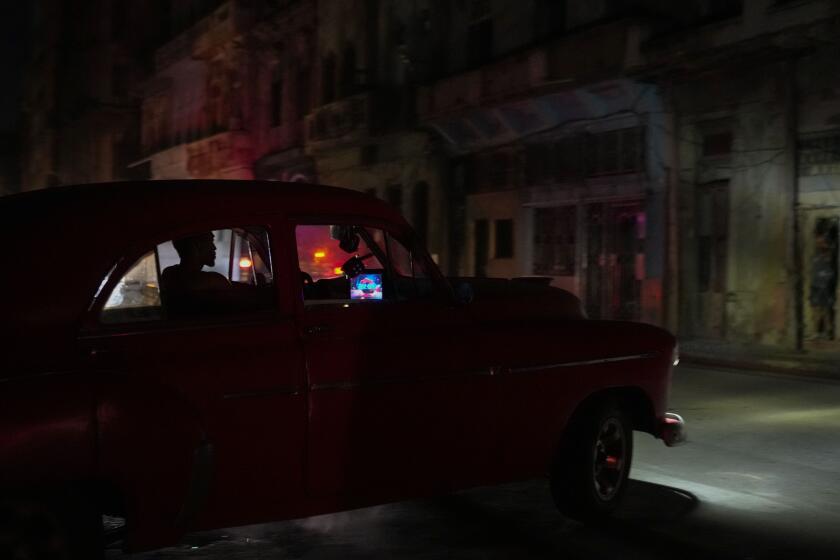Scottish Clans Spread Heritage, Tradition : Ancestry: Anyone with a trace of Scottish blood is welcome to join. Groups sponsor Highland games and gatherings, and breathe life into legends.
Andrew Macpherson adjusted the kilt over his paunch, raised the Charmed Sword high overhead and, with a sudden guttural ferocity, proclaimed his clan’s Gaelic war cry: “Creag Dhubh Chlann Chatain!”-- “Black Rock of Clan Chattan!”
Macpherson, a bespectacled, 64-year-old retired railway engineer with thinning ginger-colored hair, lowered the broadsword after a few swipes in the air. With his thumb, he tested the age-darkened steel edge of this artifact of past Macpherson glories.
“No one carrying this sword has ever been wounded in battle,” he said. “That’s the legend, anyway.”
Macpherson is curator of this little Highland town’s Clan Macpherson Museum, a place of tartan hangings, heather wreaths and ancestral memories.
With 3,000 members worldwide, nearly half in the United States (where the name is generally spelled “McPherson”), Macpherson is one of the largest of more than 40 family associations of Scots and their descendants. They are found wherever Scots have settled around the globe, including Canada, Australia, New Zealand, South Africa, the West Indies and the Far East.
Though exact totals are hard to come by, all indications are that clan rolls are steadily increasing--especially outside Scotland, where sentimental reflections on the homeland seem to be strongest.
“There is a very visible revival of the old clan societies, clan chiefs and international gatherings of the clans,” said Edinburgh University’s William Gillies, an authority on Celtic culture.
Virtually anyone with a trace of Scottish ancestry is eligible for membership in one clan or another.
“We have members in every state in the Union except North Dakota,” said the current chairman of the U.S. branch of Clan Macpherson, Larry Lee McPherson of Grand Rapids, Mich. “We’re trying to recruit somebody there.”
The status of Scottish clans today is very different from the past, when each clan was almost a self-contained kingdom, providing a semblance of government in the otherwise lawless, rugged isolation of the Highlands and western isles. But now, as then, clan life still revolves around the clan chieftain.
“At the heads of these clan organizations are chaps who, if you saw them in London, would just wear three-piece pin-stripe suits like anybody else,” Gillies said. “But when they put on their fur and feathers, they look quite different.”
The current head of Clan Macpherson is Sir William A. Macpherson, a tall, 64-year-old judge in London.
Macpherson’s family tree includes a famous clan chieftain who in 1745 sided with the Catholic pretender, Charles Edward Stuart--”Bonnie Prince Charlie”--in the disastrous Highland uprising he led against King George II.
Ewan Macpherson, a captain in the government’s Black Watch Highland regiment at the time of the rebellion, spent seven years hiding in woods and caves on his large estate around Newtonmore. Despite a substantial price on his head, his loyal clansmen never disclosed his whereabouts.
Today’s chief owns a fortified stone house in Blairgowrie, Scotland, where he occasionally entertains visiting family delegations in near-royal style.
Like other clan chieftains, Macpherson spends much of each year presiding over clan activities around the world: numerous Scottish games, an international gathering of Macphersons in Newtonmore each August and a September gathering in the United States.
This year’s U.S. gathering was held in McPherson, Kan., named for Maj. Gen. James Birdseye McPherson, who led the Army of Tennessee during the Civil War. Sir William performed his usual ceremonial duties at elaborate dinners, a family business meeting and a “kirking (blessing) of the tartan.”
As much deference as clan members show to Sir William and his wife, Lady Sheila, it is nothing compared to the status clan chieftains enjoyed in the old days, when they ruled with absolute autonomy.
They settled quarrels among their families and others in their regions, dispensed justice and provided protection from marauding neighbors. In exchange, they received the fervent loyalty of their followers, gifts and, when needed, armed men to defend their interests--usually against cattle thieves from nearby glens.
“The reason they were not as formidable as they might have been was that they were always fighting each other,” Gillies said. “You’re really talking about chaps who felt they were atop a pyramid. It didn’t matter that it was a small pyramid.”
Gillies traces the decline of the chieftains’ influence to England’s Restoration period in the 1660s, when King Charles began a deliberate campaign of encouraging the chieftains to think of themselves less as independent local warlords and more as royal courtiers.
The failure of the “Rising of the ‘45” led to 30 years of brutal suppression of the clans, including outlawing the wearing of tartan and the playing of bagpipes, which were considered weapons of war.
As hard times closed in, chieftains who managed to hold on to their land displaced their tenant farmers, planting forests and creating grazing lands for sheep.
“Those same chieftains actually destroyed the ground on which they stood,” Gillies said. “The period of the Highland clearances in the late 18th and most of the 19th centuries took away their clansmen.”
These trends resulted in the dispersal of Scots throughout the world. The clan chieftains became estate managers, and the Highlands and islands took on the aspect of brooding desolation that many visitors now perceive.
Relics in the Macpherson museum include a shattered fiddle. Celebrated in Robert Burns’ poem, “Macpherson’s Farewell,” the fiddle purportedly belonged to James Macpherson, bastard son of a clansman and a beautiful Gypsy. He became captain of a band of freebooters who roamed the northern counties, stealing--according to the family--only from the rich.
Eventually Macpherson was caught and sentenced to hang. While on the scaffold, legend has it, he took out his fiddle and played “Macpherson’s Lament,” a tune he had composed in prison.
Vowing that the fiddle would never be played again, the handsome young outlaw smashed it--and went bravely to his death.
More to Read
Sign up for Essential California
The most important California stories and recommendations in your inbox every morning.
You may occasionally receive promotional content from the Los Angeles Times.










